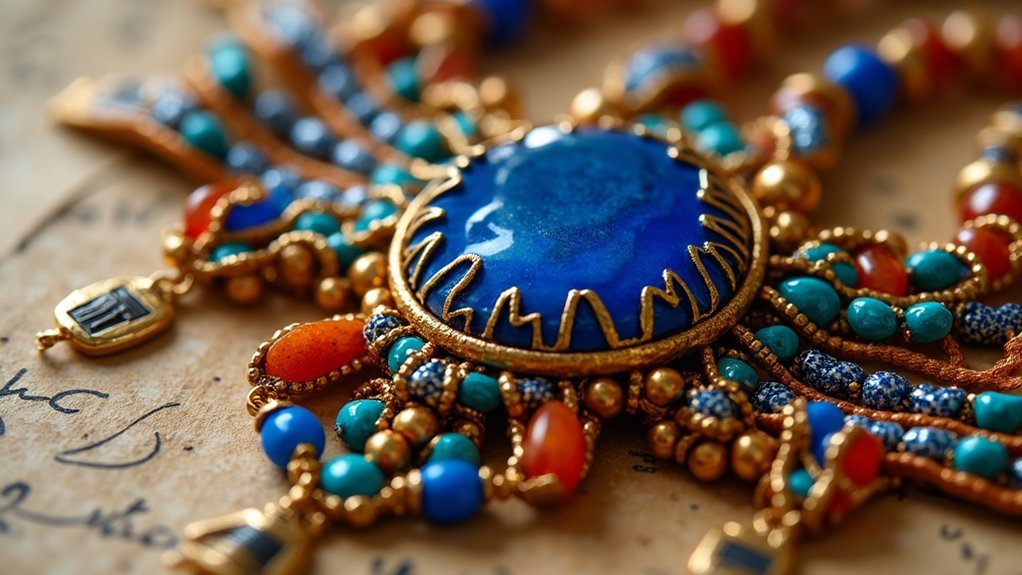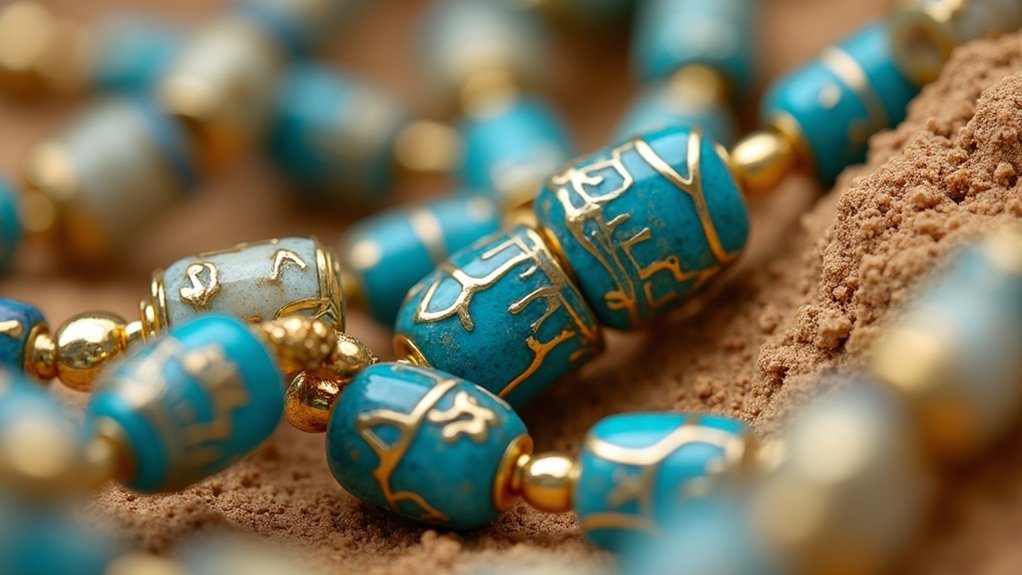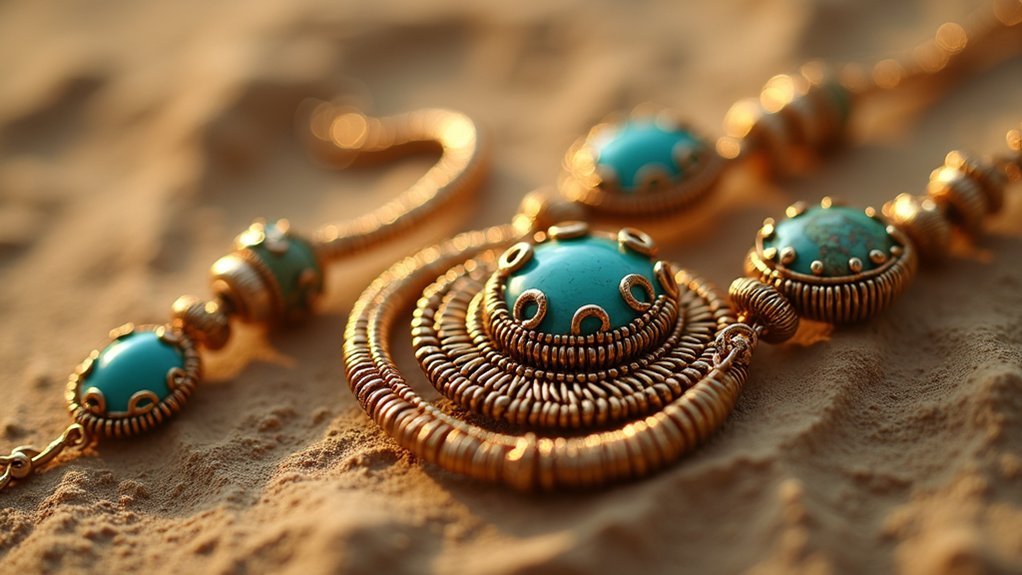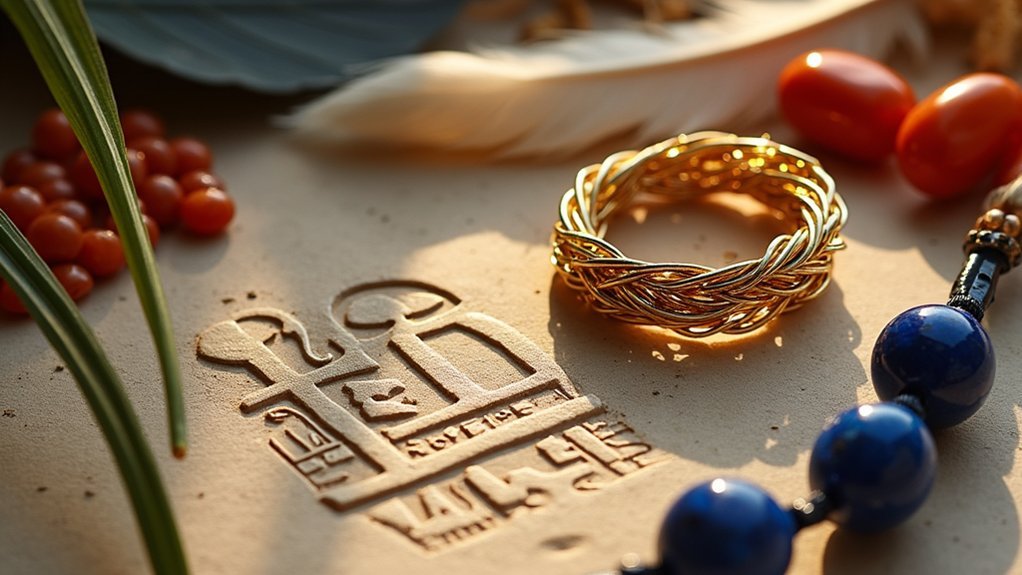To craft authentic Egyptian jewelry, use symbolic materials like gold, copper, and faience. Incorporate protective symbols such as the Eye of Horus, ankhs, and scarabs. Add personal meaning with hieroglyphs and cartouches. Master traditional techniques including wire-working, metal embossing, and bead stringing. Create wide collar necklaces and amulets with vibrant stones like lapis lazuli and turquoise. Combine different materials for visual complexity. These ancient methods will transform your modern creations into pieces with profound cultural significance.
10 Tips: Crafting Jewelry Like Ancient Egyptians

Artisans of ancient Egypt created some of history’s most stunning jewelry pieces, and you can incorporate their timeless techniques into your modern creations.
Start by selecting authentic materials—gold and copper metals paired with precious and semi-precious stones like lapis lazuli and turquoise offer that distinctive Egyptian look.
Materials speak the language of ancient Egypt—let gold, copper, lapis, and turquoise tell your story through jewelry.
For meaningful designs, integrate hieroglyphs or scarabs, powerful symbols in Egyptian art and jewelry that convey protection and status.
Try traditional techniques such as faience bead-making or metal carving to achieve authentic textures. When jewelry making, don’t forget the spiritual dimension—amulets were worn for protection, not just decoration.
Layer different materials strategically, mixing metals with colorful stones as the Egyptians did. This combination creates vibrant, eye-catching pieces that honor the sophisticated craftsmanship of this ancient civilization.
Understanding the Symbolic Significance of Ancient Egyptian Designs
Symbols gave ancient Egyptian jewelry its soul—not just its beauty. When you’re crafting pieces inspired by this ancient tradition, understanding these meanings transforms your work from mere decoration to powerful storytelling.
Incorporate hieroglyphs that convey specific messages, just as Egyptians did to express ownership or spiritual beliefs. Select precious gemstones thoughtfully—lapis lazuli and turquoise weren’t merely attractive but carried protective qualities that enhanced each piece’s symbolic significance.
Consider including deity figures like Isis or Horus in your jewelry designs to reference divine protection. Scarab motifs represent rebirth and regeneration, while cartouches traditionally enclosed royal names, connecting wearers to pharaonic power.
Essential Materials Used in Traditional Egyptian Jewelry Making

You’ll find gold at the heart of traditional Egyptian jewelry making, symbolizing divine status for pharaohs while copper served as a practical alternative for common citizens.
When selecting gemstones for your Egyptian-inspired pieces, consider authentic materials like lapis lazuli, turquoise, and carnelian, or try faience—a ceramic material ancient Egyptians used to mimic more expensive stones.
These traditional materials, combined with symbolic hieroglyphics and scarab motifs, will give your creations authentic Egyptian character while showcasing the remarkable craftsmanship techniques developed along the Nile.
Metals Worth Their Weight
Ancient Egyptian jewelry tells a profound story through its materials, with three primary metals forming the foundation of this timeless craft.
If you’re aiming to create authentic Egyptian-inspired pieces, understanding these metals is essential.
Gold stands as the most revered metal, mined along the Nile and symbolizing divinity.
You’ll find it dominated royal collections, paired with precious stones like lapis lazuli, turquoise, and carnelian for both beauty and spiritual significance.
For everyday crafting, consider copper—the metal of choice for lower classes.
It’s versatile and accessible, perfect for practicing traditional techniques.
Silver was exceptionally rare in ancient Egypt, so use it sparingly in your designs to reflect its historical value.
Don’t forget faience, the ceramic-like material frequently used for beads and amulets that carried symbolic significance.
Gemstones and Alternative Materials
Beyond the metals that formed the foundation of Egyptian jewelry, the vibrant gemstones and alternative materials brought these pieces to life with color and meaning. The ancient Egyptians prized lapis lazuli and turquoise for their striking blue colors, often incorporating them into pieces worn by the elite to symbolize wealth and divine connection.
When you’re crafting Egyptian-inspired jewelry, consider:
- Using faience to replicate the look of precious gemstones – this ceramic material was the ancient Egyptians’ ingenious solution during gemstone shortages.
- Incorporating shells, bones, and colorful rocks as accessible alternatives, just as commoners did.
- Adding symbolic hieroglyphs that transform your jewelry from mere adornment to meaningful talismans.
- Combining gemstones with alternative materials to create layered, textured pieces that tell a story.
Mastering the Wide Collar Necklace Construction Technique
While many jewelry techniques have evolved over centuries, the wide collar necklace remains one of the most striking designs inspired by ancient Egyptian craftsmanship. To create your own piece of ancient Egyptian art, start by designing a sturdy base from metallic card that comfortably fits your neck while maintaining the iconic wide shape.
| Material | Purpose | Technique |
|---|---|---|
| Metallic card | Base structure | Cut to shape |
| Faience beads | Authentic look | String in rows |
| Glass beads | Color variation | Secure with adhesive |
| Amulet charms | Cultural significance | Center placement |
| Bronze/gold paint | Luxurious finish | Apply to beads |
You’ll want to measure precisely before attaching your beads. Combine strung patterns with decorative elements like scarabs, securing everything firmly for a durable piece that showcases this timeless jewelry style.
Creating Protective Amulets With Authentic Egyptian Motifs

Creating authentic Egyptian amulets requires understanding the powerful symbolism behind motifs like scarabs and ankhs, which ancient Egyptians believed offered divine protection and rebirth.
You’ll want to master working with traditional materials such as clay or faience, coloring them with vibrant blues and greens to mirror the sacred pieces found in tombs and temples.
For maximum authenticity, incorporate essential protection symbols like the Eye of Horus, the djed pillar, or specific deity names using carefully carved hieroglyphs that transform your creation from mere jewelry into a meaningful spiritual object.
Symbolic Meaning Behind Amulets
Ancient Egyptian amulets represent far more than decorative jewelry pieces; they embody powerful protective forces that guided wearers both in life and the afterlife.
When you’re crafting these symbolic talismans, understanding their deeper meanings will enhance their authenticity and personal significance.
- Scarab beetles symbolize rebirth and transformation, connecting the wearer to Ra’s daily journey across the sky.
- Hieroglyphic inscriptions aren’t merely decorative—they’re powerful invocations to specific deities for protection.
- Material selection matters considerably—lapis lazuli represented the heavens while turquoise embodied rebirth.
- Animal motifs like falcons (Horus) or cats (Bastet) channel specific divine attributes and protections.
Clay and Faience Techniques
Artisans of ancient Egypt pioneered faience, a remarkable glazed ceramic that you can recreate today for authentic protective amulets.
Begin by mixing fine sand, lime, and a touch of copper for that signature blue-green color. Form your clay into small objects like scarabs or hieroglyphs that symbolize rebirth and protection.
After shaping your amulet, let it dry completely before firing. The magic happens during firing, when the copper rises to the surface, creating that distinctive glossy finish.
You’ll want to incorporate detailed carving techniques to achieve the intricate designs that showcase true Egyptian craftsmanship.
Remember that protective amulets weren’t just decorative—they served spiritual purposes. As you craft yours, consider adding hieroglyphs believed to ward off evil or bestow blessings, honoring the profound cultural significance behind these ancient treasures.
Essential Protection Symbols
When crafting Egyptian-inspired protective amulets, you’ll need to understand the powerful symbols that give these pieces their spiritual significance. The ancient Egyptians believed these protective symbols could shield the wearer from harm when properly incorporated into jewelry.
Select materials like gold or semi-precious stones to enhance your amulet’s power while reflecting the wearer’s status.
- The Eye of Horus offers protection and health benefits when carved into pendants.
- Scarab beetle designs symbolize rebirth and regeneration, guiding the wearer through life changes.
- Hieroglyphs engraved on your protective jewelry can spell out names of gods or protective spells.
- Wearing these symbolic amulets around the neck maximizes their protective qualities while serving as beautiful decorative pieces.
Replicating Faience: The Egyptian Art of Glazed Ceramics

The mesmerizing blue-green gleam of Egyptian faience represents one of history’s most ingenious artistic innovations. You can recreate this ancient glazed ceramic technique using a mixture of sand, lime, and alkali. Shape your creation, then apply a copper-silica glaze to achieve those vibrant colors that mimic precious stones.
| Material | Purpose | Historical Significance |
|---|---|---|
| Sand | Base material | Primary structural component |
| Lime | Binding agent | Enhanced durability |
| Alkali | Flux for glazing | Lowered firing temperature |
| Copper | Colorant | Created turquoise/blue hues |
| Silica | Glaze formation | Produced glossy finish |
When crafting faience jewelry, remember its spiritual significance—Egyptians believed these pieces protected the deceased in the afterlife. Try forming beads into flowers, animals, or geometric designs for authentic Egyptian-inspired accessories.
Incorporating Hieroglyphs and Sacred Symbols Into Your Pieces
Ancient Egyptian hieroglyphs offer modern jewelry makers a treasure trove of meaningful symbols to incorporate into their designs. You can add these sacred symbols using stamping or engraving techniques, transforming simple pieces into powerful personal adornment that tells a story.
Consider using cartouches—oval frames containing hieroglyphs—to personalize pieces with names or meaningful words, just as ancient Egyptians did for their pharaohs.
The royal cartouche transforms ordinary jewelry into personal talismans, carrying your identity in the sacred language of the gods.
- The ankh symbol represents eternal life and can be featured as a pendant or charm.
- Scarab beetles symbolize rebirth and protection, making them perfect centerpieces.
- The Eye of Horus offers protection and royal power to the wearer.
- Hieroglyphic inscriptions allow you to create jewelry with personalized messages.
Enhance your designs with traditional materials like lapis lazuli or turquoise to authentically capture Egyptian aesthetics while incorporating these powerful symbols.
Wire-Working Methods From the Nile Valley Tradition

Ancient Egyptian wire-working offers you two distinct approaches: looping creates open, flowing designs while coiling produces tighter, more structured patterns.
You’ll achieve authentic Nile Valley aesthetics by combining these techniques with traditional hieroglyphic symbols as pendants.
Try incorporating cartouche-style wire frames around symbolic hieroglyphs for pieces that honor both the craftsmanship and spiritual significance of Egyptian jewelry traditions.
Looping Vs Coiling Techniques
Two fundamental wire-working methods from the Nile Valley tradition continue to influence jewelry making today: looping and coiling techniques.
When you create looping designs, you’ll form closed circles with wire to attach beads and decorative elements, mirroring ancient Egyptian jewelry practices.
Coiling, meanwhile, involves manipulating wire into spirals and complex shapes, adding dimension to your pieces.
You can experiment with different wire gauges for each technique:
- Thinner wires (24-28 gauge) work best for delicate loops and intricate coils
- Medium wires (20-22 gauge) provide balance between flexibility and strength
- Heavier wires (16-18 gauge) create structural elements and bold statements
- Combining gauges achieves the layered complexity seen in traditional Nile Valley designs
Try blending both techniques with gemstones to capture authentic Egyptian aesthetic qualities.
Authentic Hieroglyphic Pendants
Several authentic hieroglyphic pendants can be crafted using traditional Nile Valley wire techniques to connect you with Egypt’s rich symbolic heritage.
Begin by researching ancient Egyptian symbols that offer protection or blessings before incorporating them into your design.
As a jewelry artist, you’ll want to master wire-wrapping with copper or brass—metals favored by Egyptian craftsmen.
Create cartouches by shaping wire into oval frames that house your chosen hieroglyphs, traditionally used for royal names.
Experiment with different wire gauges to achieve varied textures that reflect the diverse craftsmanship of ornate jewelry from this period.
Finally, apply an antiquing solution to your finished piece, giving it the weathered appearance of authentic artifacts.
This patina enhances the pendant’s historical character while honoring the ancient Egyptian metalworking tradition.
Beadwork Patterns and Stringing Techniques of the Pharaohs
The Egyptian pharaohs and their artisans mastered intricate beadwork techniques that remain impressive even by today’s standards. When creating your own Egyptian-inspired jewelry, you’ll want to combine cylindrical, round, and disc-shaped beads made from materials like glass and stone.
Ancient Egyptians secured these with linen or leather cords, tying knots between beads to prevent sliding—a technique you can replicate for durability.
- Incorporate turquoise and lapis lazuli colors to infuse your pieces with authentic symbolic meaning of liveliness and protection
- Layer beads with precious metals or wire wrapping to achieve the complex, multi-dimensional look of royal Egyptian jewelry
- Add scarab shapes between beads as protective elements, just as ancient artisans did
- Space your knots strategically to create rhythm in your beadwork patterns
Metal Embossing and Hammering in the Egyptian Style
Beyond beadwork, ancient Egyptian jewelry artisans excelled in metal embossing and hammering techniques that created stunning sculptural pieces. You’ll want to start by annealing your metal sheets—heating them until they’re pliable enough to work with.
| Tool | Effect |
|---|---|
| Flat hammer | Smooths metal surfaces |
| Rounded hammer | Creates domed shapes |
| Chasing tool | Makes detailed indentations |
| Wooden mallet | Gentle shaping without marking |
| Burnisher | Polishes raised designs |
Try using different hammering techniques to texturize gold or copper sheets. Create raised hieroglyphs or animal motifs that reflect authentic ancient Egyptian jewelry styles. Once you’ve completed the embossing, consider embellishing your piece with precious stones or enamel to enhance its visual appeal and symbolic significance.
Frequently Asked Questions
What Was the Technique of Making Egyptian Jewelry?
Ancient Egyptians crafted jewelry through goldsmithing, using techniques like casting, soldering, and hammering. They’d engrave hieroglyphs into metals and incorporate semi-precious stones like lapis lazuli, turquoise, and carnelian into their intricate designs.
How Did They Make Jewelry in Ancient Times?
In ancient Egypt, you’d find artisans using gold and semi-precious stones. They’d craft jewelry through beadwork, casting, and metalworking. They’re known for their intricate designs featuring protective symbols and hieroglyphs.
What Techniques Were Used in Ancient Egyptian Art?
You’ll find ancient Egyptian art employed techniques like relief carving, hieroglyphic inscription, encaustic painting, metalworking, and vitreous inlay. They’re renowned for their precise proportions, symbolic coloration, and stylized figures depicting life and afterlife.
What Are the Basic Techniques in Making Jewelry?
You’ll start with wire wrapping, beading, and stringing as foundational jewelry techniques. Learn soldering for joining metals, texturing for detail, and metal forming. Don’t forget setting gemstones and creating clasps for finished pieces.
In Summary
You’ve now explored the world of Egyptian jewelry crafting! Remember, patience is your greatest ally. As you practice these ancient techniques, you’re connecting with artisans who created masterpieces thousands of years ago. Don’t rush your work—find joy in the process. Whether you’re making a sacred amulet or a beaded collar, you’re preserving traditions that have captivated the world for millennia.





Leave a Reply